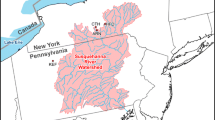Abstract
Atmospheric stability conditions in the atmospheric surface layer control the distance and direction of transport of air contaminants. Near confined animal facilities, transport processes significantly impact air quality as these sites typically act as point sources of dust and odor constituents; however, little information is available on atmospheric stability effects. This study was conducted to assess year-round temporal patterns of atmospheric stability at a swine production facility and an adjacent commercial corn field (CF) in the US Midwest. Two towers of 10 and 20 m heights for continuous micrometeorological measurements were deployed within a CF and between swine buildings (BSB), respectively. Each tower was equipped with an eddy-covariance system at 6.8 m height, infrared thermometers, and six cup anemometers with thermocouples installed at log-distributed heights. Overall results from gradient Richardson number and Monin–Obukhov (z/L) calculations revealed a greater prevalence of unstable conditions for BSB compared with CF. During the 13-month measurement period, unstable cases (z/L ranging from −1 to −0.01) occurred 1.4 times more frequently for BSB than CF (52 vs. 39%, respectively), while stable cases (0.011–0.2) were 1.8 times more frequent for CF than BSB (24 vs. 14%, respectively). These patterns were partly associated with higher surface radiometric temperatures for BSB. Relatively greater diurnal heat capture at BSB (ground and roof surfaces) and a cooling effect in CF through active canopy transpiration during the daytime explain these z/L and radiometric temperature results. Prevalent diurnal atmospheric instability at BSB suggests enhanced ascendant vertical transport of air pollutants perhaps causing greater mixing/dilution with the atmospheric layer and/or their facilitated transport over greater distances when sorbed onto particles. This enhanced understanding of the spatio-temporal patterns of atmospheric stability can be subsequently applied in further studies for identifying effective odor mitigation strategies near commercial animal production facilities.







Similar content being viewed by others

References
Arya SP (2001) Introduction to micrometeorology. Academic, San Diego
Barr AG, Morgenstern K, Black TA, McCaughey JH, Nesic Z (2006) Surface energy balance closure by the eddy-covariance method above three boreal forest stands and implications for the measurement of the CO2 flux. Agr Forest Meteorol 140:322–337
Bartholy J, Radics K (2005) Wind profile analysis and atmospheric stability over a complex terrain in southwestern part of Hungary. Phys Chem Earth 30:195–200
Foken T (2008) Micrometeorology. Springer, Berlin, Heidelberg
Fritz BK (2006) Meteorological effects on deposition and drift of aerially applied sprays. Trans ASABE 49:1295–1301
Guo H, Jacobson LD, Schmidt DR, Nicolai RE (2003) Evaluation of the influence of atmospheric conditions on odor dispersion from animal production sites. T ASAE 46:461–466
Haeger-Eugensson M (1999) Vertical interactions in a nocturnal multi-scale wind system influenced by atmospheric stability in a coastal area. Theor Appl Climatol 64:69–82
Haeger-Eugensson M, Holmer B (1999) Advection caused by the urban heat island circulation as a regulating factor on the nocturnal urban heat island. Int J Climatol 19:975–988
Hatfield JL, Baker JM (eds) (2005) Micrometeorology in agricultural systems. American Society of Agronomy, Madison
Hernandez-Ramirez G, Hatfield JL, Prueger JH, Sauer TJ (2010) Energy balance and turbulent flux partitioning in a corn-soybean rotation in the Midwestern U.S. Theor Appl Climatol 100:79–92
Jegede OO, Fasheun TA, Adeyefa ZD, Balogun AA (1997) The effect of atmospheric stability on the surface-layer characteristics in a low-wind area of tropicalWest Africa. Bound-Layer Meteorol 85:309–323
Katul GG, Parlange MB, Albertson JD, Chu CR (1995a) Local isotropy and anisotropy in the sheared and heated atmospheric surface-layer. Boundary-Layer Meteorol 72:123–148
Katul GG, Goltz SM, Hsieh C-I, Cheng Y, Mowry F, Sigmon J (1995b) Estimation of surface heat and momentum fluxes using the flux-variance method above uniform and nonuniform terrain. Boundary-Layer Meteorol 74:237–260
Monteith JL, Unsworth MH (2008) Principles of environmental physics, 3rd edn. Elsevier, Academic Press, Amsterdam, Boston
Pasquill F (1961) The estimation of the dispersion of windborne material. Meteorology Mag 90(1063):33–49
Prueger JH, Eichinger WE, Hipps LE, Hatfield JL, Cooper DI (2008) Air-flow distortion and turbulence statistics near an animal facility. Atmos Environ 42(14):3301–3314
Rosenberg NJ, Blad BL, Verma SB (1983) Microclimate: The biological environment, 2nd edn. John Wiley & Sons, New York
Sauer TJ, Hatfield JL, Prueger JH (1996) Aerodynamic characteristics of standing corn stubble. Agron J 88:733–739
Stull RB (1988) An introduction to boundary layer meteorology. Kluwer Academic Publ, Dordrecht, the Netherlands
SYSTAT Software (2009) SigmaPlot Version 11.0 SPSS, Chicago
Thistle HW (2000) The role of stability in fine pesticide droplet dispersion in the atmosphere: A review of physical concepts. Trans ASAE 43(6):1409–1413
Thom A (1975) Momentum, mass and heat exchange of plant communities. In: Monteith J (ed) Vegetation and the atmosphere. Academic, New York
Zoumakis NM, Kelessis AG (1991) The dependence of bulk Richardson number on stability in the surface layer. Boundary-Layer Meteorol 57:407–414
Acknowledgments
We sincerely thank Kevin Jensen, Kathleen Lewis, Forrest Goodman, Richard Pfeiffer, Allison Schlapkohl, Timothy Hart, and David E. James for their valuable technical assistance including installation and maintenance of the field instrumentation. Also, appreciation is extended to Kent J. Schwartz for facilitating the implementation of this study on his farm.
Open Access
This article is distributed under the terms of the Creative Commons Attribution Noncommercial License which permits any noncommercial use, distribution, and reproduction in any medium, provided the original author(s) and source are credited.
Author information
Authors and Affiliations
Corresponding author
Rights and permissions
About this article
Cite this article
Hernandez-Ramirez, G., Sauer, T.J., Hatfield, J.L. et al. Quantifying atmospheric stability conditions at a swine facility and an adjacent corn field in Iowa, USA. Theor Appl Climatol 105, 495–503 (2011). https://doi.org/10.1007/s00704-011-0405-0
Received:
Accepted:
Published:
Issue Date:
DOI: https://doi.org/10.1007/s00704-011-0405-0



